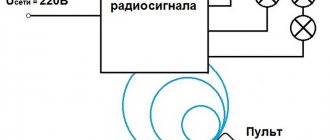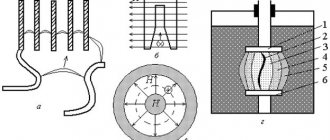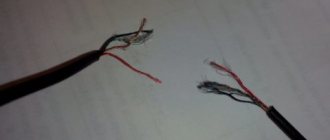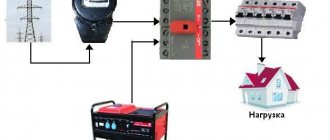In different parts of our planet, about 2000 thunderstorms are raging simultaneously and approximately 50 lightning strikes the Earth's surface every second. Humanity has been studying lightning for a long time, but only a quarter of a century ago, the American scientist Benjamin Franklin proved that lightning is an electrical discharge carrying a negative charge. Today, high-speed photography has made it possible to establish that the flash consists of several short discharges lasting tenths of a second.
How and why lightning occurs
Lightning in most cases forms in cumulonimbus clouds, and sometimes in large nimbostratus clouds. Thunderclouds stand out clearly from the rest due to their rich dark color.
The dark blue hue comes from the thickness of the cloud. Moreover, its lower edge is located at an altitude of about 1 km above the earth’s surface, and the upper edge reaches 6-7 km in height.
As you know, a cloud consists of water vapor. At altitude, the droplets freeze and turn into ice crystals. Due to uneven temperature distribution, heated air rises and carries with it small particles of ice. At the same time, larger frozen floes fall down - particles constantly collide.
Lightning formation
During a collision, the ice floes are electrified (the same phenomenon as during friction of different objects). Smaller particles receive a positive charge, and larger ones receive a negative charge. Different parts of the cloud are charged accordingly. At the top there is a thundercloud with a plus sign, and at the bottom with a minus sign.
The result is a potential difference. Moreover, it is formed both between different parts of the cloud, and between the cloud and the ground. This difference is measured in hundreds of thousands of volts.
Lightning does not appear instantly out of nothing, although it moves quite quickly. The formation of lightning can be divided into initial, middle and final stages.
initial stage
The discharge appears in a certain part of the cloud where a large number of ions are present. An ion is a particle with an electrical charge. It occurs when an atom or molecule gains or loses electrons.
The same thing happens with a thundercloud. Ions are formed due to molecules of water and gases, of which, in fact, the cloud consists. At this stage, the opinions of scientists differ, since it has not yet been possible to thoroughly study the nature of lightning.
Scheme of development of ground lightning
Some experts believe that a high concentration of ions is due to the acceleration of free electrons. They are always present in the air, albeit in a small volume. These electrons then collide with neutrally charged molecules, causing them to ionize.
According to another hypothesis, it's all about cosmic radiation. It also affects the Earth's atmosphere constantly. This is how air is ionized. Ionized gas is a good conductor of electricity, so current passes through it in the cloud.
Middle stage
Then a chain reaction starts. The current passing under high voltage heats the air in a certain area. More and more energetic particles are formed, which convert neighboring regions into ions. Therefore, lightning travels extremely quickly.
Stages of a downward lightning strike
Lightning has a dominant part - the most powerful channel, from which branches spread in different directions. This explains the tortuous shape of the discharges: with each new flash, the lightning seems to move in leaps and bounds further and further by about several tens of meters.
Interesting fact : sometimes the speed of the “main” lightning reaches 50,000 km per second.
At a certain moment, the most powerful discharge reaches the earth's surface or another part of the cloud. But this is not the end. As soon as an electrical discharge breaks through an ionized channel several centimeters thick, charged particles pass through it at high speed. In fact, this is lightning that we can observe.
Due to the high voltage, the temperature inside this channel is measured in thousands of degrees. That's why we see lightning as a very bright flash. Thunder is a consequence of a sharp change in temperature and pressure. During an electrical discharge, a huge amount of energy is released, despite the short duration of the phenomenon.
Final stage
The speed of charge movement along the channel decreases rapidly. However, the voltage and current still remain very high. It is at the final stage that lightning usually reaches the ground and various objects.
Final stage of lightning
If there are people nearby, lightning becomes very dangerous. The final stage takes not even a second, but tenths of it. But this is enough to cause damage, fires, etc. Lightning often strikes the same place several times if this path is the shortest and most “convenient” for the discharge.
Interesting: Wind: what is it, how is it formed, types, wind strength, photos and videos
Electrostatic discharge
In the beginning there was the word. In our case: in the beginning there was a concentration of charge. The main condition for electrostatic phenomena is the accumulation of charge on the surface of the body. We had plenty of time to discuss why and how the charge is formed. Now the interest is completely different: why in some cases the interaction of a charged body with objects results in attraction or repulsion, and in some cases leads to an electrostatic discharge , sometimes accompanied by sparks?
First, it would be appropriate to define:
Electrostatic discharge is an uncontrolled sudden release of electrical charge between bodies.
Let us repeat that the quality of the discharge is uncontrollable: a fast, sudden flow of charge redistribution between bodies, lasting a fraction of a second. In contrast, it is clear that electrostatic attraction or repulsion is a process that takes some time.
The redistribution of electrons occurs slowly and gradually, when compared with a discharge. If there is a strong electronic imbalance between bodies - a body with a huge negative charge interacts with the same, but positively charged one - this leads to a rapid exchange of charges.
Types of lightning
Lightning is divided into many types. The main criterion is the nature of the discharge formation, because lightning can occur at different heights. They can also have different shapes, lengths and other parameters.
Types of lightning in the layers of the atmosphere
Linear (cloud-ground)
A common species that occurs due to different charges of the upper and lower parts of the cloud. Linear lightning appears and develops according to the principle described earlier - as a result of active ionization of air. From the main leading channel, flashes diverge stepwise in different directions, reaching the ground at the final stage.
Linear lightning
Earth-cloud
Objects located at high altitudes often attract lightning, accumulating electrostatic charge. Ground-to-cloud discharges occur as a result of the penetration of the atmospheric layer between the bottom of a thundercloud and the charged top.
Ground-to-cloud lightning
Cloud-cloud
Most lightning occurs among clouds. Flashes are formed as a result of different parts of clouds having different charges. Therefore, nearby clouds pierce each other with electrical discharges.
Cloud-to-cloud lightning
Interesting fact : in Venezuela there is a unique place where the Catatumbo River flows into Lake Maracaibo. There is a lot of lightning here all year round (usually at night), which flashes continuously for a long time. The frequency of discharges is 250 per square kilometer per year. The highest peak is May and October.
Horizontal
Similar to cloud-to-ground, but does not reach the earth's surface. The outbreaks spread in different directions. Such lightning is considered extremely powerful. For its formation, one thundercloud in a clear sky is enough.
Horizontal zipper
Tape
Lightning takes on an interesting form, in which several identical channels rush down parallel to each other at a short distance. The reason probably lies in the strong wind, which widens these channels.
Tape zipper
Beaded (dotted)
A rare type of lightning, the nature of which has been little studied. The discharge does not occur in a continuous line, but with frequent small intervals - dotted lines. It is possible that some areas of the lightning cool quickly, giving it this shape. The flash lasts a couple of seconds, and the lightning itself strikes in a wave and only in one trace.
Beaded lightning
Curtain
Occurs above the clouds, and not inside or below them, like previous types. How exactly it is formed is unknown. Externally, it is a wide luminous stripe consisting of a large number of discharges. At the same time, you can hear a low hum. The first time such lightning was captured was in 1994.
Curtain zipper
Sprite
If ordinary lightning occurs at an altitude of about 16 km, then sprites appear much higher - 50-130 km. They are electrical discharges of cold plasma shooting upward from the clouds.
Sprites
It’s difficult to see them, but sprites are formed in groups during every strong thunderstorm, a few seconds after powerful lightning. The average length of flashes is 60 km, diameter is up to 100 km, duration is up to 100 milliseconds.
Elf
Large-scale cone-shaped flares with weak red light (diameter approximately 400 km). Formed in the upper layers of thunderclouds. They reach a height of 100 km and last about 3 milliseconds.
Elf
Jet
Tubular-cone-shaped lightning with a blue glow. The height reaches the lower layers of the ionosphere (from 40 to 70 km). In terms of duration they are slightly ahead of the elves.
Jets
Volcanic
Occurs during a volcanic eruption. This is probably due to the fact that the ash and magma carry an electrical charge when ejected. In addition, these particles constantly collide, which causes discharges.
Volcanic lightning
Saint Elmo's Fire
In fact, this is not lightning, but discharges that occur at the pointed ends of towering objects. This includes the tops of rocks, trees, ship masts, towers, etc. They are formed due to high electric field strength. Most often this happens during a thunderstorm or snowstorm in winter.
Saint Elmo's Fire
Ball
Lightning in the form of a spherical plasma clot floating directly in the air. How and why such a discharge is formed has not yet been established by scientists. All we can say for certain is that such lightning behaves unpredictably. Many still doubt its existence.
Ball lightning, 19th century engraving
Third stage
Ionization, remember? The strong electron field of the cloud affects both the earth's surface and the air.
Of course, ionization of air occurs unevenly, from a charged cloud in portions along “curved” trajectories. The air is heterogeneous, contains dust and all sorts of microelements, so some atoms turn into ions faster, others more slowly. By the way, here’s the reason why lightning looks jagged—broken lines spreading in different directions. It follows the path of least electrical resistance.
Lightning color
Lightning can have different shades: bluish, white, yellow, orange, red. The color depends on the composition of the atmosphere. The lightning channel heats up 5 times hotter than the Sun. At this temperature, the air is characterized by blue and violet tones. Therefore, discharges visible nearby in a clear atmosphere acquire a bluish glow.
The bluish glow of lightning is the most common
At a greater distance, the flashes become white, and even further away they turn yellow. This happens because blue tones are scattered in the air. If there is a lot of dust in the atmosphere, the flashes turn orange.
Drops of water “color” the lightning in red shades. The most rare phenomenon is the creation of complex optical effects due to a high concentration of small ice particles in the air.
Speed and length of lightning
On average, lightning moves at a speed of about 56 thousand km/sec. In this case, a thunderstorm atmospheric phenomenon moves at a speed of 40 km/h. The average length of an electric discharge is 9.5 km.
Interesting: Living and inanimate nature - what is it, definition, description and photo
Old photo of lightning in Boston
Interesting fact : the longest lightning strike in the world was recorded in the American state of Oklahoma - 321 km. And the longest discharge in time was observed in the Alps - for 7.74 seconds.
Lightning frequency
Early studies showed that lightning strikes approximately 100 times per second across our planet. But satellites make it possible to observe the most remote or hard-to-reach places on Earth.
Lightning frequency (per square kilometer per year)
New data indicates 44 plus or minus 5 lightning strikes per second. This means that about 1.4 billion electrical discharges occur per year. Of these, approximately 25% strike the ground, and the remaining 75% erupt among the clouds.
How to determine the distance to lightning from thunder?
The distance to a thunderstorm can be determined approximately by thunder. To do this, it is recorded how many seconds pass between the sound of thunder and the flash of lightning. It is necessary to take into account the speed of sound - about 300 meters per second. So, 3 seconds is approximately 1 km before a thunderstorm.
Distance to lightning
Taking several measurements allows you to know whether a thunderstorm is approaching or moving away in relation to the observer. It is important to remember that lightning stretches for several kilometers. If lightning strikes are visible in the absence of thunder, it means that a thunderstorm is more than 20 km away.
Consequences of lightning
Lightning leaves behind a large number of different traces, depending on where the discharge strikes and its power. Consider the following manifestations of lightning:
- formation of fulgurites;
- hitting the ground;
- hitting trees, houses and other objects;
- hitting cars;
- hitting a person.
Fulgurite is a substance that is formed when an electrical discharge hits sand or any rock. Essentially, a certain amount of sand simply melts and hardens under short-term exposure to high temperature.
Fulgurite
Fulgurites are not easy to find. They are usually found on mountain tops or in areas where thunderstorms are common. Getting into sand deposits, lightning forms tubes of arbitrary shapes from it, hollow inside. In fact, they turn out to be glass.
There is always moisture and air between sand particles. A powerful blow quickly heats them to high temperatures and expands, as a result of which these tubes of various sizes and shapes appear. They are then instantly cooled.
Very rarely, lightning strikes strike the ground, since the shortest and most accessible path is preferable for them. But in the event of a hit, a depression remains on the surface, from which ornate lines, reminiscent of lightning in shape, go in different directions.
Lightning trace on the ground
Rising above other objects, trees most often attract lightning. In most cases, they burn out, and instantly. If ball lightning hits a tree, it sets it on fire from the inside. When lightning strikes a building, it often damages the roofing part and can also cause a fire.
Lightning struck a tree
If the discharge hits a closed vehicle, such as a car, it will quickly spread throughout the metal body and go into the earth's surface. It is believed that a car is a safe place in which you can wait out bad weather, since lightning does not get inside the cabin. However, the consequences of a direct hit are still serious.
Lightning struck a car
A person being struck by lightning is unpredictable. It is comparable to an electric shock, but the voltage is many times higher. Most often, lightning strikes the chest or head.
Lichtenberg figures
Special marks remain on the body, which resemble lightning in shape - they are called Lichtenberg figures. This mark remains as a result of damage to blood vessels. Being struck by lightning is extremely dangerous, so in the event of a thunderstorm you should take all necessary safety measures.
What danger does a thunderstorm pose?
Lightning is a charge of electricity of enormous power that causes destruction and fire. If a discharge of this kind hits a person, it causes serious injury or death. Cardiac arrest may occur, the nervous system is destroyed and the brain is affected. According to statistics, lightning strikes a person only in one percent of cases, however, this is quite dangerous.
A shock wave of one discharge breaks a tree into splinters, stuns, causes serious burns, etc. This natural element is merciless.
Is it possible to use lightning energy?
There is a special term - lightning energy. This is the way in which lightning energy is “harvested” and directed into electrical networks. This energy belongs to the number of alternative renewable sources.
Electrical networks
The potential for using lightning energy is enormous. Its supply is endless - it will solve the problem of expensive electricity and reduce the damage that is currently being caused to the planet’s ecology. Currently, experimental installations for capturing lightning are being developed, and thunderstorm activity is being studied.
Interesting: Photosynthesis - what is it, definition, how it happens, phases, meaning, photos and videos
But this method of energy consumption also has its disadvantages. It is difficult to predict where and when a thunderstorm will occur. In addition, the flash lasts a fraction of a second, so powerful, expensive equipment is required.
What to do during a thunderstorm?
If you find a thunderstorm outside, you must follow these rules:
- You cannot hide under trees and other tall objects, or stand next to poles or road signs, which are most often struck by lightning. You should move away from them, since the tension diverges in different directions from the center of the impact.
- In an open area, you need to sit down and press your head to your knees, taking the lowest possible place.
- Move your umbrella and all metal and long objects away from you - they attract lightning.
- Turn off your phone and other devices.
- If possible, take shelter in the car.
- Do not approach the reservoir, especially do not swim.
What to do during a thunderstorm
While indoors, you should also turn off your telephone, electrical appliances, and gas supply. It is recommended to close all windows. There is a version that even the beam of a laser pointer aimed at the sky can attract a discharge.
Interesting fact : there is a concept of step voltage. It occurs between two points on the surface, and the greater the distance between these points, the higher the current strength. For example, cattle and horses are at greater risk because their front and rear legs are located far away.
Amazing fireball
One of the least studied, and therefore most mysterious, natural phenomena is considered to be ball lightning - a glowing plasma ball moving through the air. It is mysterious because the principle of the formation of ball lightning is unknown to this day: despite the fact that there are a large number of hypotheses explaining the reasons for the appearance of this amazing natural phenomenon, objections have been found to each of them. Scientists have never been able to experimentally achieve the formation of ball lightning.
Ball lightning can exist for a long time and move along an unpredictable trajectory. For example, it is quite capable of hovering in the air for several seconds and then darting to the side.
Unlike a simple discharge, there is always only one plasma ball: until two or more fiery lightning bolts were recorded simultaneously. The dimensions of ball lightning range from 10 to 20 cm. Ball lightning is characterized by white, orange or blue tones, although other colors, even black, are often found.
Scientists have not yet determined the temperature indicators of ball lightning: despite the fact that, according to their calculations, it should range from one hundred to a thousand degrees Celsius, people who were close to this phenomenon did not feel the heat emanating from the ball lightning.
The main difficulty in studying this phenomenon is that scientists are rarely able to record its occurrence, and eyewitness testimony often casts doubt on the fact that the phenomenon they observed was indeed ball lightning. First of all, testimonies differ regarding the conditions under which she appeared: she was mainly seen during a thunderstorm.
There are also indications that ball lightning can appear on a fine day: it can descend from the clouds, appear in the air, or appear from behind an object (a tree or a pillar).
Another characteristic feature of ball lightning is its penetration into closed rooms, it has even been noticed in pilot cockpits (the fireball can penetrate windows, go down ventilation ducts and even fly out of sockets or a TV). Situations have also been repeatedly documented when a plasma ball was fixed in one place and constantly appeared there.
Often the appearance of ball lightning does not cause trouble (it moves calmly in air currents and after some time flies away or disappears). But sad consequences were also noticed when it exploded, instantly evaporating the liquid located nearby, melting glass and metal.
Possible dangers
Since the appearance of ball lightning is always unexpected, when you see this unique phenomenon near you, the main thing is not to panic, not to move abruptly and not to run anywhere: fire lightning is very susceptible to air vibrations. It is necessary to quietly leave the trajectory of the ball and try to stay as far away from it as possible. If a person is indoors, you need to slowly walk to the window opening and open the window: there are many stories when a dangerous ball left the apartment.
You cannot throw anything into a plasma ball: it is quite capable of exploding, and this is fraught not only with burns or loss of consciousness, but also with cardiac arrest. If it happens that the electric ball catches a person, you need to move him to a ventilated room, wrap him warmly, perform a heart massage, perform artificial respiration and immediately call a doctor.
Koalas are the original representatives of the living world of Australia93304.811
How are planes protected from lightning?
The entire aircraft body is protected by a special shell, which contains a metal shielding mesh inside. Thus, when struck by lightning, the shell conducts current, but prevents the electrical discharge from penetrating into the aircraft. People and equipment inside remain safe.
Arresters on the wing of an airplane
Also, all technical equipment of the aircraft is equipped with additional protection against electrical discharges. A lightning strike occurs on the nose of the aircraft, the discharge moves towards the wings and tail. Passengers and crew may hear a loud sound during an impact, but this does not always happen.
Interesting fact : before the aircraft is put into operation, it undergoes a thorough check. One of its stages is the simulation of a lightning strike.
Fourth stage
Everything is ready for the discharge from above, and electrons from the cloud rush down along ionized paths. The crowd, as they say, has gone. The charge approaches the ground, expanding the range of the electric field, to which forced positively charged bodies on the surface begin to react more actively.
They, sensing the opposite charge, strive to rise higher to the cloud. Due to the charge moving from the surface, the ionization process is completed from below.
Now the path for the electrical discharge is completely trodden. The negative flow continues on its way and finally meets the positive...
Boom! Lightning.
Think for yourself . When removing a wool sweater in a dry room, you may hear a characteristic electrostatic crackling sound. Lightning doesn't happen in silence either. What does lightning have to do with a crackling sweater? Where does the sound of thunder come from? And why is there a time difference between the sound and visual effects?
How do you protect equipment from lightning?
You need to understand that there is no protection against direct lightning strikes on equipment. We are talking about lightning protection - this is special equipment that allows you to protect equipment from damage caused by thunderstorms. Lightning rods are also installed and equipment is protected from overvoltage.
Lightning protection
The main purpose of lightning protection is to protect equipment from static electricity. It has a certain protection indicator, designated as ESD Protection. This indicator is measured in kilovolts and is indicated as a numerical value.
Lightning protection standard is 15-20 kV. It is a diode bridge. When a voltage difference of 6 V or more is detected in the wires, a protective diode is triggered, which grounds the wires.
Interesting Facts
There are many interesting and shocking facts related to this natural phenomenon:
- only a quarter of the discharges reach the earth's surface;
- the chance of death from being struck by lightning is only 1 in 2 million, the same is the risk of dying from falling out of bed;
- the longest discharge was recorded in 2007 and its length was 321 km;
- the longest lightning flash lasted 7.74 seconds;
- Lightning causes about 10 thousand forest fires annually;
- on average, around the world, about 3 thousand people die from lightning strikes;
- the most common reason for a person to be struck by lightning is the fact of talking on a mobile phone during a thunderstorm;
- 70% of people struck by lightning survive. It is known that the American Roy Sullivan was hit by lightning seven times and after that he remained alive;
- The lifespan of ball lightning is 10 seconds, and the probability of seeing it at least once in your life is comparable to 1:10000;
- A similar phenomenon is observed not only in the earth’s atmosphere. Thunderstorms and flares also occur on Jupiter, Saturn, Uranus and Venus.
Understanding how lightning is formed in thunderclouds and what it is will help you treat this phenomenon without neglect. If you behave incorrectly during a thunderstorm, lightning poses a direct danger to human health and life. Therefore, it is important not to forget to turn off your mobile phone in time and try to find suitable shelter during the storm.
History of the study
People have been able to observe lightning since ancient times, but for a long time there was no explanation for this phenomenon. Initially, it was believed that flashes in the sky were the result of the activities of the gods. Even ancient Greek philosophers noticed that lightning strikes tall objects.
Mariners made a significant contribution to the study of lightning. On the open sea, electrical discharges turned out to be even more powerful. The connection between lightning and electricity was put forward in the 17th and 18th centuries, during the development of physics.
Lightning in the sea
Benjamin Franklin described this hypothesis in most detail in his studies. In 1750, he presented a scientific work in which the now famous experiment to determine the electrical nature of lightning was described.
The essence of the experiment was to fly a kite during a thunderstorm. At the same time, a copper rod was attached to the kite, and a metal key was attached to the cable. The purpose of the experiment is to prove the electrical nature of lightning.
The Benjamin Franklin Experience, illustration
To confirm the hypothesis, lightning must strike the kite, travel along the cable and leave a mark on the key. Franklin carried out the experiment in June, taking care of the lightning rod. It is worth saying that it was successful and confirmed all the physicist’s guesses.
In the 20th century, scientists discovered unusual types of lightning (sprites, jets, elves) that occur in the upper atmosphere. Currently, lightning research is carried out using satellites.











